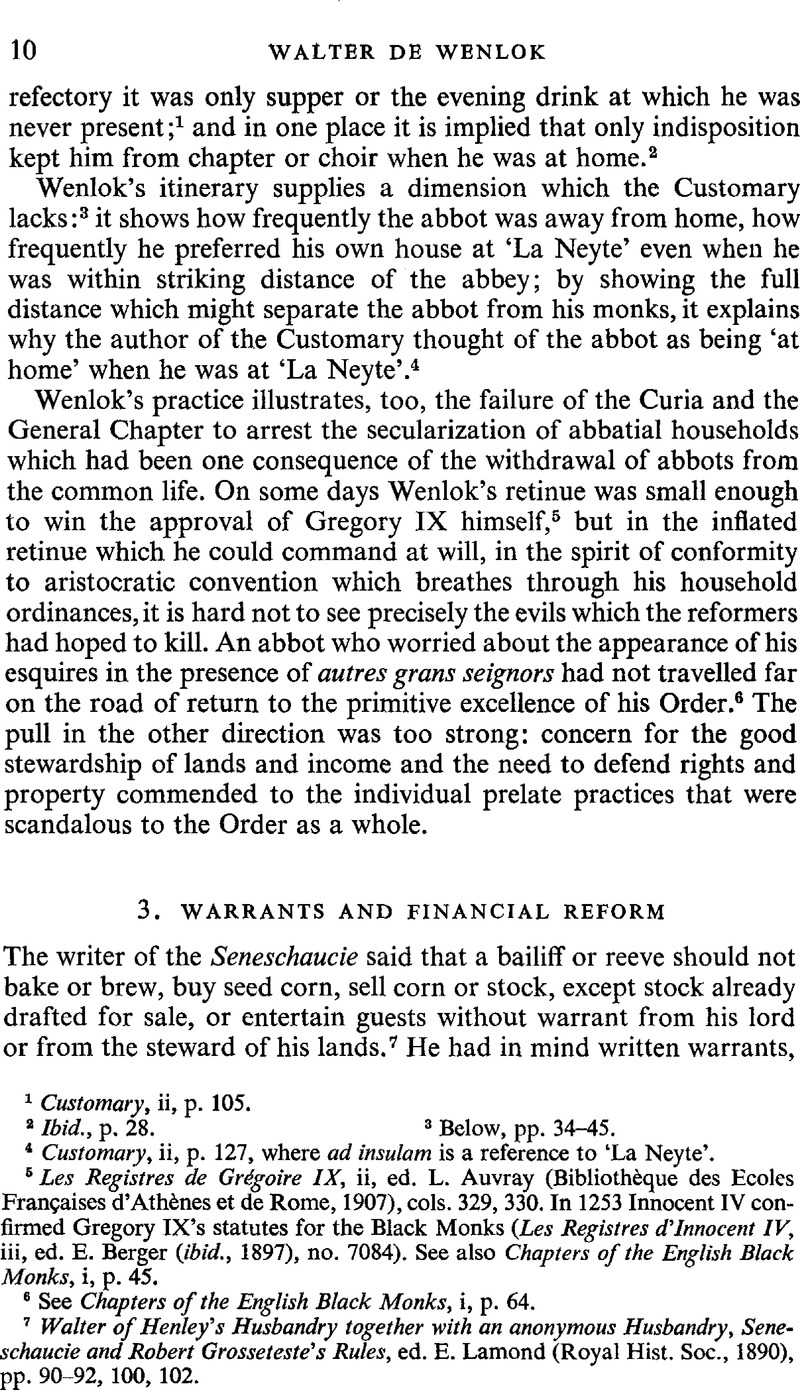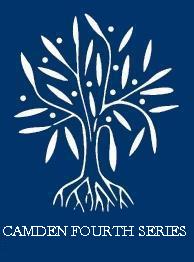No CrossRef data available.
Article contents
3. Warrants and Financial Reform
Published online by Cambridge University Press: 21 December 2009
Abstract

- Type
- Introduction
- Information
- Camden Fourth Series , Volume 2: Documents Illustrating the Rule of Walter de Wenlok, Abbot of Westminister, 1283–1307 , July 1965 , pp. 10 - 17
- Copyright
- Copyright © Royal Historical Society 1965
References
page 10 note 7 Walter of Henley's Husbandry together with an anonymous Husbandry, Seneschaucie and Robert Grosseteste's Rules, ed. Lamond, E. (Royal Hist. Soc., 1890), pp. 90–92, 100, 102.Google Scholar
page 11 note 1 Denholm-Young, N., Seignorial Administration in England (Oxford, 1937), pp. 75, 162, 165–66Google Scholar; see also Somerville, R., History of the Duchy of Lancaster, i, 1265–1603 (London, 1953), p. 106.Google Scholar
page 11 note 2 For references to written warrants see Pipe Roll of the Bishopric of Winchester, 1208–1209, ed. Hall, H. (London, 1903), pp. 17, 22, 38Google Scholar, etc.; Wellingborough Manorial Accounts A.D. 1258–1323, ed. Page, F. M. (Northamptonshire Record Soc., viii, 1936), pp. 129, 130Google Scholar; Ministers' Accounts of the Earldom of Cornwall, 1296–1297, ed. Midgley, L. M., ii (Camden Third Ser., lxviii, 1945), pp. 157, 201Google Scholar; Neilson, N., Economic Conditions on the Manors of Ramsey Abbey (Philadelphia, 1899), Appendix, pp. 9, 30Google Scholar. The terms breve and littera in ministers' accounts betray written warrants; preceptum and mandatum may refer to oral commands.
page 11 note 3 B.M., Add. MS. 8167, fos 131v-33. See Church Quarterly Review, xcv (1922–1923), pp. 335–37.Google Scholar
page 11 note 4 Davenport, F. G., Economic Development of a Norfolk Manor, 1086–1565 (Cambridge, 1906), pp. 25Google Scholar note, xxxvj; Ministers' Accounts of the Manor of Petworth, 1347–53, ed. Salzman, L. F. (Sussex Record Soc., lv, 1955), p. 55.Google Scholar
page 11 note 5 Gras, N. S. B. and Gras, E. C., Economic and Social History of an English Village (Cambridge, Mass., 1930), p. 232Google Scholar; Red Book of Worcester, ed. Hellings, M. (Worcestershire Hist. Soc., 1934–1950), part ii, p. 225Google Scholar. Sometimes the ‘writs’ carried would be letters of a less formal kind, such as passed between Simon de Senliz and Ralph Nevili, bishop of Chichester (Royal and Other Historical Letters Illustrative of the Reign of Henry III, i (1216–1235), ed. Shirley, W. W. (Rolls Ser., 1862), pp. 247–48, etc.).Google Scholar
page 11 note 6 I. 113, 171, 299 300, etc.
page 11 note 7 I. 51, 168, 326–27.
page 11 note 8 I. 40, 114, 272.
page 11 note 9 I. 29–30, 94–95, 101, etc.
page 12 note 1 I. 38–39, 112.
page 12 note 2 I. 36, 148, 309, etc.
page 12 note 3 I. 18, 130, 135, 314, etc. The word ‘assignment’ is used in this volume to mean the direct application of manorial issues to meet abbatial debts, etc., without the intervention of any central collecting officer.
page 12 note 4 Ware was treasurer from 1280 to 1283 (Tout, , Chapters, vi, p. 19Google Scholar). For per breve entries in accounts dating from his abbacy see W.A.M. 27392–94.
page 12 note 5 The Staines account for 1294–95 records the expense of sending to Sutton-under-Brailes for a warrant pro diversis negociis (W.A.M. 16916).
page 12 note 6 I. 28, 33, 43, 47, 292, 300, 303, 318; see also I. 293.
page 12 note 7 See below, p. 28 and note. The ministers' accounts for ‘Eye’ sometimes note that a payment has been made or corn sold in the presence of or on the authority of the monk-warden of ‘La Neyte’ (W.A.M. 26858, 26871).
The manor of ‘Eye’ adjoined the Abbey's property in Westminster; see Archaeologia, lxii (1910), i, pp. 31–53Google Scholar. The name is now obsolete. Already in Wenlok's day the form Ebury was sometimes used, but this did not become common until later in the fourteenth century and in its strict sense it denoted the manor of ‘Eye’ excluding ‘La Neyte’ (for which see I. 22, note) and the lands incorporated in the sub-manor of Hyde.
page 12 note 8 W.A.M. 22093.
page 13 note 1 I. 7; see also below, p. 163.
page 13 note 2 Below, p. 158. For the abbot's valuables see also Pearce, , Walter de Wenlok, p. 44.Google Scholar
page 13 note 3 II. 1 and 3. The second of the two rolls for the year Mar. 1288–Mar. 1289 is not extant but is mentioned in the record of the audit of the steward's accounts in June 1289 (below, p. 158).
page 13 note 4 Day-accounts are extant for parts of the years 1284, 1286–92 and 1298–99 (W.A.M. 9241, 24490 95, 9252, 9242, 24507, 24501–2).
page 13 note 5 Below, p. 241.
page 13 note 6 W.A.M. 24491. Less than half the steward's expenditure between Sept. 1288 and Mar. 1289 appears on the day-account for this period (below, p. 158 and note).
page 14 note 1 W.A.M. 24491.
page 14 note 2 II. 2.
page 14 note 3 II. 3. The current classified expenses account was rendered by the principal steward alone (II. 5).
page 14 note 4 Below, p. 241.
page 14 note 5 W.A.M. 28980 ff. For examples of payments made by the receivers outside Westminster or London see I. 70, 236, and notes.
page 14 note 6 Below, p. 27, note.
page 14 note 7 Below, p. 241; see also above, p. 1.
page 14 note 8 I. 54.
page 14 note 9 W.A.M. 8246, 25922, 16837, 27111, 26859; Gloucester County Records Office, 1099/M31/13. At Staines in this year more was delivered to the abbot's receivers than to the stewards of the household (W.A.M. 16916).
page 14 note 10 Below, p. 27.
page 15 note 1 II. 6.
page 15 note 2 W.A.M. 16921, 16841, 27399, 25928, 8249; Gloucester County Records Office, 1099/M31/17. The accounts for the abbot's other manors are not extant this year.
page 15 note 3 Below, p. 27.
page 15 note 4 I.142–43.
page 15 note 5 I.154, 186, 191, 208–9, etc.; see also II. 7–9. The abbot's receiver is described as thesaurarius in 1307, but since the same official is intended the title of receiver has been used throughout this volume.
page 15 note 6 See Monks, pp. 73–74.Google Scholar
page 15 note 7 W.A.M. 8264–68, 27407–12, 25947, 25949, 14787–88, etc.
page 15 note 8 The accounts for Hendon rectory in 1325 and for Oakham rectory in 1329–30 record liveries of money to Brother Robert de Curtlington for the house-hold (W.A.M. 32625, 20349); the presumption is that Brother Robert was steward of the household. The Oakham entry is noted by Pearce (Monks, p. 78Google Scholar); the Hendon reference I owe to Mr L. E. Tanner.
page 15 note 9 W.A.M. 24681. This account covers the period 22 Dec. 1342–13 Apr. 1343. Later in the century a separate receipt was established for the abbot's manors in Worcs. and Gloucs., but the steward of the household continued to act as receiver for the other manors and no attempt was made to restrict the chamber to purely domestic expenditure (W.A.M. 24404 ff., 24510 ff.).
page 16 note 1 Below, p. 241.
page 16 note 2 I. 67, 102, 187, 205, 217, 220, 224, 239, 241.
page 16 note 3 E.g. I. 211, 216.
page 16 note 4 See below, pp. 34–45. Down to 1292 the itinerary is based mainly on the household day-accounts; after 1292 it is based mainly on writs, and, in the context of the abbot's itinerary, these have a bias which the day-accounts lack, because those writs addressed to the receivers were usually executed in or near Westminster. Nevertheless, it is clear that visits to Westminster and ‘La Neyte’ were more regular and frequent in Wenlok's later years than they had been earlier.
page 16 note 5 I. 262.
page 16 note 6 Below, p. 211.
page 17 note 1 Below, pp. 211–13.
page 17 note 2 Below, p. 208; see also p. 212.
page 17 note 3 Smith, R. A. L., ‘The Regimen Scaccarii in English Monasteries’, Trans. Roy. Hist. Soc., 4th Ser., xxiv (1942), pp. 73 ff.CrossRefGoogle Scholar


